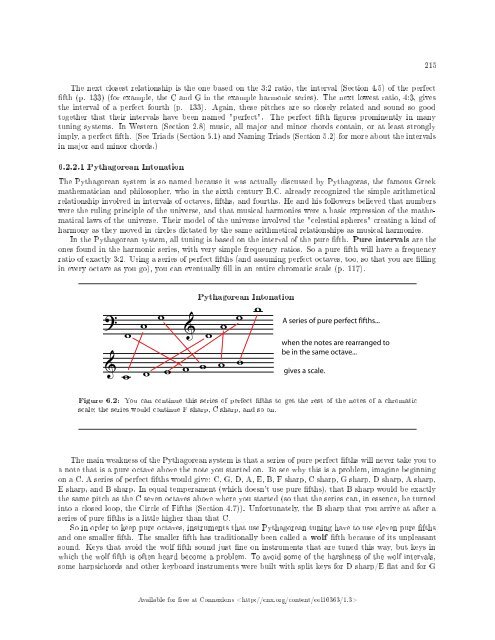Understanding Basic Music Theory, 2013a
Understanding Basic Music Theory, 2013a
Understanding Basic Music Theory, 2013a
Create successful ePaper yourself
Turn your PDF publications into a flip-book with our unique Google optimized e-Paper software.
215<br />
The next closest relationship is the one based on the 3:2 ratio, the interval (Section 4.5) of the perfect<br />
fth (p. 133) (for example, the Cand G in the example harmonic series). The next lowest ratio, 4:3, gives<br />
the interval of a perfect fourth (p. 133). Again, these pitches are so closely related and sound so good<br />
together that their intervals have been named "perfect". The perfect fth gures prominently in many<br />
tuning systems. In Western (Section 2.8) music, all major and minor chords contain, or at least strongly<br />
imply, a perfect fth. (See Triads (Section 5.1) and Naming Triads (Section 5.2) for more about the intervals<br />
in major and minor chords.)<br />
6.2.2.1 Pythagorean Intonation<br />
The Pythagorean system is so named because it was actually discussed by Pythagoras, the famous Greek<br />
mathematician and philosopher, who in the sixth century B.C. already recognized the simple arithmetical<br />
relationship involved in intervals of octaves, fths, and fourths. He and his followers believed that numbers<br />
were the ruling principle of the universe, and that musical harmonies were a basic expression of the mathematical<br />
laws of the universe. Their model of the universe involved the "celestial spheres" creating a kind of<br />
harmony as they moved in circles dictated by the same arithmetical relationships as musical harmonies.<br />
In the Pythagorean system, all tuning is based on the interval of the pure fth. Pure intervals are the<br />
ones found in the harmonic series, with very simple frequency ratios. So a pure fth will have a frequency<br />
ratio of exactly 3:2. Using a series of perfect fths (and assuming perfect octaves, too, so that you are lling<br />
in every octave as you go), you can eventually ll in an entire chromatic scale (p. 117).<br />
Pythagorean Intonation<br />
Figure 6.2: You can continue this series of perfect fths to get the rest of the notes of a chromatic<br />
scale; the series would continue F sharp, C sharp, and so on.<br />
The main weakness of the Pythagorean system is that a series of pure perfect fths will never take you to<br />
a note that is a pure octave above the note you started on. To see why this is a problem, imagine beginning<br />
on a C. A series of perfect fths would give: C, G, D, A, E, B, F sharp, C sharp, G sharp, D sharp, A sharp,<br />
E sharp, and B sharp. In equal temperament (which doesn't use pure fths), that B sharp would be exactly<br />
the same pitch as the Cseven octaves above where you started (so that the series can, in essence, be turned<br />
into a closed loop, the Circle of Fifths (Section 4.7)). Unfortunately, the B sharp that you arrive at after a<br />
series of pure fths is a little higher than that C.<br />
So in order to keep pure octaves, instruments that use Pythagorean tuning have to use eleven pure fths<br />
and one smaller fth. The smaller fth has traditionally been called a wolf fth because of its unpleasant<br />
sound. Keys that avoid the wolf fth sound just ne on instruments that are tuned this way, but keys in<br />
which the wolf fth is often heard become a problem. To avoid some of the harshness of the wolf intervals,<br />
some harpsichords and other keyboard instruments were built with split keys for D sharp/E at and for G<br />
Available for free at Connexions


















